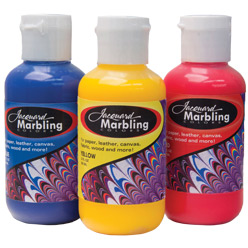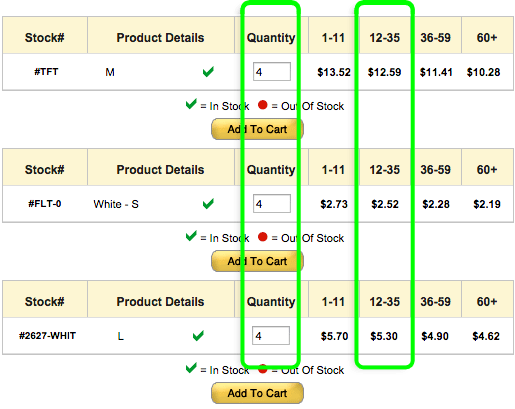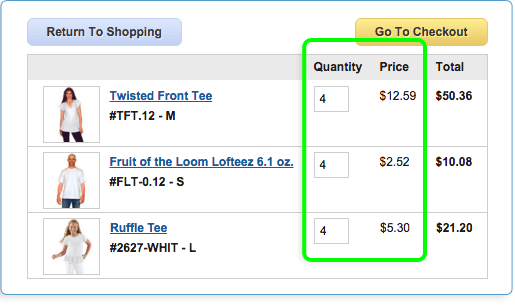Our friends at Jacquard rose to the challenge and have been working diligently to improve your marbling experience. They succeeded! The Jacquard Marbling Colors are formulated for ease of use and professional results. All colors spread equally (except black, which spreads more deliberately, and is usually used first) on the marbling size and have good adhesion on any porous or semi-porous substrate. No more problems with some colors sinking and some spreading too much. The color selection is small, but all the colors can be mixed to your heart's content to create new colors.
Synthetic Gall (replaces the older Versatex Dispersing Agent) gives marblers total control of their colors and allows for adjustments in how much one color spreads in relation to another. On Fabric, Jacquard Marbling Colors are soft, permanent and washfast after heat-setting. Please note - marbling requires lots of trial and error! Every marbling situation will vary, and it may take some time and troubleshooting to master this unique surface design technique - but it will be worth every minute!
Jacquard Marbling Instructions
For a succinct visual guide from Jacquard Click Here.
Pretreat fabric or paper with mordant
A mordant must be used on paper and fabric so that the marbled design will adhere to the fiber or paper quickly and permanently. Alum-treated fabric or paper should be used within 2 days or placed in an airtight container or bag as the alum deteriorates, and also can "rot" fabric if left on too long.
For Fabric: Dissolve 2 teaspoons of alum in one gallon of warm water. For best results, prewash or use PFD (prepared for dyeing) fabric. Do not use fabric softener! Submerge fabric in alum solution and soak for 20 min. Wring out and line dry. Iron fabric before marbling on a low heat setting. Be careful not to scorch the fabric. For hard water use Calgon water softener, one tablespoon per quart.
For Paper: Dissolve 2 teaspoons of alum in one quart of warm water. Fill a marbling tray with the alum solution and submerge each piece of paper one at a time. Leave these pages for 20-30 min. in the alum solution and then line dry.
Experiment with different types of paper and see which is best for you. Some papers do not work for marbling at all.
Watercolor paper is not recommended. Color will not stick to these papers properly and will actually run off the page.
Papers that work well are smooth and contain little to no sizing. Masa and Hosho rice paper are two that perform particularly well.
Wash the tray carefully if you plan to use the same tray for marbling. Alum will contaminate the carrageenan and prevent your paint from sticking to the paper.
Prepare the marbling base or size
Carrageenan is a natural seaweed derivative used to thicken water to create the marbling size. Mixed carrageenan will only keep for a few days at room temperature. The warmer it is, the faster it will go bad! If it gets moldy, smells bad, or becomes thin, discard it. Refrigeration will extend the life of carrageenan to a week or two, but even refrigerated size can go bad. As it ages it thins, and paints that would normally float on the surface begin to sink. Methocel is also used for make size, as it doesn't go bad nearly as quickly and is more economical, however it is not recommended for beginners because it is much harder to use. For one thing, it gets foamy and it is hard to get all the bubbles to settle out. It also has to rest longer than carrageenan before use.
Using a whisk or blender, slowly add 2 tablespoons of carrageenan per gallon of warm tap water. Blend for about 10 minutes or until all carrageenan is dispersed. Allow to rest for 12 hours before pouring into the marbling tray. If you are hand mixing with a whisk, make sure there are no clumps of carrageenan left in your mixture. Clumps tend to disappear the longer you let the mixture rest, so if you get a stubborn lump leave it alone for awhile. A closed one gallon container can be shaken instead of stirred. Using a blender is substantially easier and quicker than hand mixing carrageenan, but it does cause bubbles that need to be skimmed or allowed to settle before marbling.
Before you marble
Just before you begin applying paint, clean the size of any air bubbles and dust by laying newspaper or a paper towel on the surface and dragging it towards you. Skimming is very important because it removes any size that prevents the paint from spreading evenly. You can apply paint directly from the bottles; however, if you want to use brushes to flick smaller dots onto the surface it can be helpful to have small open containers or a palette with wells. This also makes it easier to mix colors. You can get a nice pumpkin orange from mixing the red and yellow, and if you mix the blue and red, you get a different purple than the violet provided in the kit. White will show up well on your print if you compress it into tight veins with the other colors, but large spots will look clear on colored fabric or paper. White is also great for mixing and making lighter, more pastel looking colors. These colors, since they all float equally, are infinitely intermixable!
Applying the paint to the size
Begin by gently dropping the paint, one drop at a time onto the surface of the marbling base. Do this using an eyedropper, squeeze bottle, straw brush or stylus dipped in paint. Colors can be placed randomly or in patterns. Concentric circles are made by adding drops of different colors to the centers of previous circles (bullseye pattern). As you apply the colors you will see a concentrated dot in the middle of each expanding ring of color. If you wait for this concentrated dot to spread evenly before applying the next color, you will get better adhesion and better color separation, especially when making concentric rings.
Each color should spread to the same extent with the exception of black, which spreads the most and is traditionally applied first. This gives the rest of the colors definition and provides good contrast. You should be able to apply the colors in any sequence you want. Usually, the last color will be your dominant color. Experiment with how much paint is applied to the surface for different effects. When large amounts of paint are dripped directly from the bottle, the final colors are very bright and vibrant. When paint is flicked in tiny drops from a straw brush, the colors will be lighter and more pastel. Sometimes if too much paint is on the surface of the size, it will run, even on paper that was thoroughly treated with alum. Diluting the paints slightly with water can fix this issue. Running color is rarely a problem on fabric.
Using the Gall
Gall is the clear liquid in the squeeze bottle. Rather than using the traditional animal product, Ox Gall, Jacquard's gall is synthetic. Gall makes the paints spread more on the sizing. Add it to the paint to make one color dominate over the others. Gall should not be added directly to any of the paint bottles as you cannot decrease the amount a color spreads once the gall is added. Add one drop at a time in a secondary jar or palette until the color spreads as desired. Gall may also be used to create voids in the design. The gall is powerful. Do not add it directly to the surface of the size, as it will cause a giant hole to appear in your design. Instead, dilute the gall by putting one or two drops into one teaspoon of water (adjust concentration to your preference), then you can add it to your marble to push the colors into tight veins or create little clear voids in the design. Flicking the diluted gall from a brush causes a honeycomb-like effect. Gall can add a whole other dimension to marbling and gives you much more control over the behavior of the paints. Be aware that If you get too much Gall building up in the size, it will effect how future applications of paint float and spread.
Making the Pattern
Typically, the design is achieved by combing the colors that are floating on the size. Here are some patterns to try:
- Stone: This is the pattern generated when spots of paint are spattered or dropped onto the size without any combing. This is a beautiful effect that may also be used as a beginning for the combed patterns. Try using different sized applicators, like an eyedropper or straw brush, to make stones of different sizes. Gall is very useful for making stones of different sizes from the same color.
- Snail: After making a stone pattern, use a stylus or rake to make a spiraling, snail-like pattern.
- Get-gel (back and forth): Start with a Stone pattern, then draw through the size with a stylus, up and down in one direction, then back and forth in the other.
- Rake Nonpareil: Start with a Get-gel, then use a rake or comb to draw across it.
Create other patterns by using variations of these basic patterns. Try varying the widths of the teeth in the combs or rakes. Use squiggly lines as you draw through the size instead of straight ones. Combine patterns, such as: Stone on top of Get-gel, Snail on top of nonpareil, etc.
Picking up the Color
Hold the paper or fabric on opposite sides in a slight upward curve, and lay it down on the size. Holding opposite corners diagonal from each other is very effective. The middle of the paper or fabric should touch first; then gently let go of the sides. This will keep any air from getting trapped underneath. If the fabric seems too floppy, you can hold by two corners of a short end and lay down from the other short end. After a few seconds, lift the paper or fabric off from one edge. It helps to place the fabric or paper flat on a board paint side up once removed from the tray. You want to do it quickly so that alum doesn't contaminate your sizing, which will cause the paint to start not sticking in future dips.
Rinse** under a gentle stream of cold water for 20 seconds or less to remove all the size. The color will remain on the fabric or paper. Try not to touch or rub the surface at this stage or you might smear the design. If color comes off in the rinse, either the jet of water is too strong or you have washed too long. After a few tries you will learn how to wash long enough to get off all the size, but not so long that the pigment washes off. Hang on a line to dry or lay flat. **New tip - allow the size to stay on for one or two days before rinsing - you will get more color adhesion! Just no longer with fabric as you don't want that alum left on the fabric for too long.
For fabric, heat set the paints by ironing once it has dried for at least 24 hours. Allowing several days (up to one week) before washing can greatly improve colorfastness. Then hand wash cold or machine wash on a gentle cycle with low agitation. Paper does not need to be heat set.
Skim the surface of the size after each print to remove any residual paint. Once the surface is clean, start over and make another unique design. This is an important step to keep any stray floating color from contaminating your next beautiful design.
Clean up
When you are finished marbling, discard unused size down a sink drain while running hot tap water. It is organic and totally safe. The paints are water based, non-toxic, and wash up fine with warm soapy water.
Do keep all paints and chemicals out of reach of small children.
Tips and Troubleshooting
- Make sure the paints, chemicals, and the size are all at room temperature. Differences in temperature will affect results.
- When working with T-shirts, insert cardboard to stretch fabric and keep it rigid. This will make it easier to handle and help to avoid white seams along the sleeves or sides.
- Marble tennis shoes by starting at one side and rolling evenly across the surface of the size.
- Marbling colors will not adhere to wet fabric or paper. Keep this in mind when marbling on T-shirts or other double-sided projects.
- Size is very slippery! Clean up floor spills immediately.
- Clean the surface of the size right before you start a design each time. You want to remove any bubbles, dust, surface film or stray pigment.
- Stars instead of circles indicate that a film or skin has congealed on the surface of the size and needs to be skimmed off. Prevent the formation of film by resting newsprint, paper towels or other inexpensive paper on the surface of the size during breaks between prints.
- Hard water and minerals can affect results. You may consider using distilled water or adding some Calgon water softener. Size that is too thin can be an indicator of hard water.
- If the size is too thick, the marbling colors will not spread as much and will be dragged along on the comb instead of cut cleanly in half. Add more water to thin down the size.
- Thicker size is better for stone or marbled patterns, while thinner size works better for combed patterns. Adjust the amount of water in the size according to the desired pattern.
- Release the drops of paint close to the surface of the size. A drop applied from a greater distance will have more force to break the surface tension and cause the paint to sink.
- Alum-treated paper or fabric can oxidize, so treated items should be used within 2 days to make sure the mordant is still effective. Treated paper and fabric can be preserved by storing in an airtight bag or container.
- More alum does not make the paint stick better. Too much alum will cause the paint to bind to the alum instead of the fibers of the paper or fabric.
- Leaving the alum paper or fabric on the surface of the size longer does not help the paint stick any better. In fact it allows alum to contaminate the carrageenan which can prevent subsequent prints from sticking properly.
- Working fast is always better. The longer the color stays on the size the more it breaks up or shatters. It's best not to work on a pattern much longer than 4 minutes because paint left too long looks broken up by tiny micro cracks.




































































